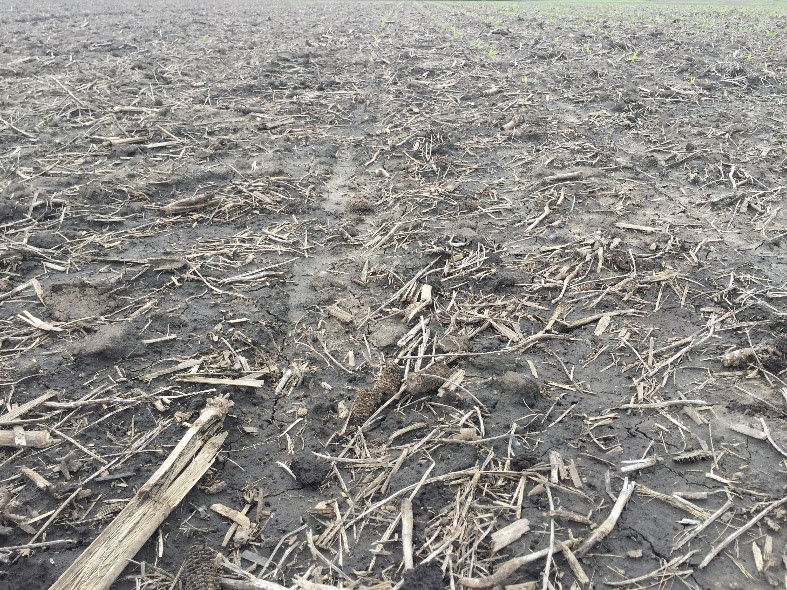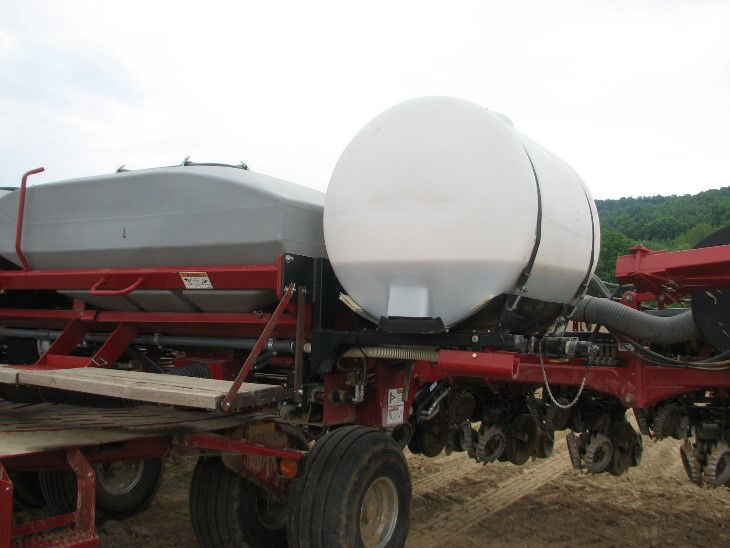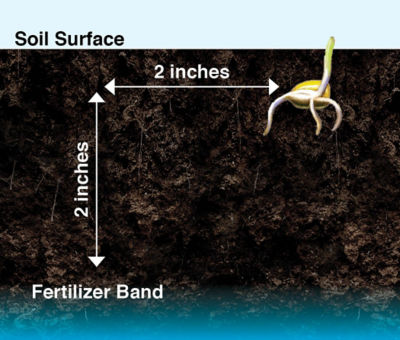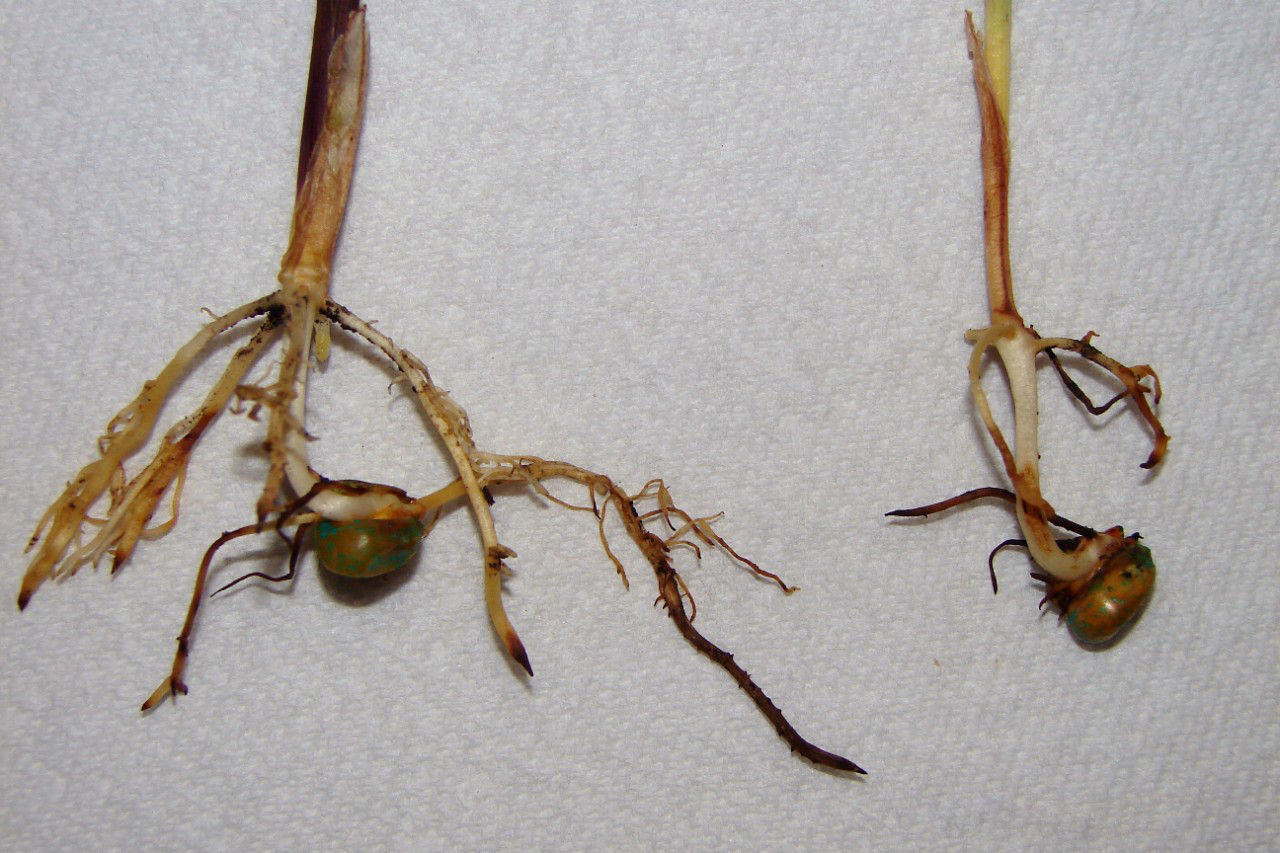5 MIN READ
Understanding Differences in Starter Fertilizers
June 5, 2025
- Starter fertilizer can help corn seedling establishment by providing nutrients close to the seed.
- Phosphorus is a primary component of starter fertilizers and helps increase plant root growth.
- The placement and type of starter fertilizer used is crucial because of the potential for seed and root injury by the salts contained in the products.
Starter fertilizers are fertility products that are used primarily in corn production. The products are used in small amounts and placed close to the seed at planting to help enhance the growth and development of emerging seedlings, particularly when soils are wet and cold which are more common under conservation tillage operations (Figure 1). Starter fertilizer application equipment is generally attached to the planter (Figure 2).


Starter fertilizers are usually a mix of at least nitrogen (N) and phosphorus (P). A starter should have a high phosphate (P2O5) ratio such as 1-2-1, 1-3-1, 1-4-2, or 1-5-0.1 Potassium (K), sulfur (S), and zinc (Zn) may be added based on soil nutrient tests and soil type. A fertilizer product does not have to be called a starter to be used as such. Nutrient percentages within a product are associated with the numerical analysis for the product. The first number is the percent N, the second is the percent P2O5, and the third is the percent potash (K2O). As an example, 10-10-10 is 10 percent N, 10 percent P2O5, and 10 percent K2O. Common analyses that may be used as a starter include 10-10-10, 10-20-10, 8-32-16, 8-28-12, 7-21-7, 9-18-9, 11-52-0, and 10-34-0.1 If manure has been regularly applied, the soil may test high in P and K; therefore, a N only material such as 34-0-0 should be considered.1
Starter placement is placed close to the seed with the most common placement two inches to the side and two inches below the corn seed (2 x 2) at planting (Figure 3) and helps reduce the potential for injury from fertilizer burn (Figure 4). In-furrow or pop-up and dribble (over the seed furrow) are other application methods; however, the practice is riskier because of the potential for seed and root injury as the fertilizer is in close contact with the seed. Fertilizer rates should be closely monitored when placed with the seed because of the injury potential.1


Salt Index and the Potential for Seed and Seedling Injury
Fertilizers contain salts that dissociate into ionic forms in water resulting water within the roots being pulled out resulting in tissue desiccation, particularly under dry soil conditions. Under moist soil conditions, salts can diffuse away from the seed in the soil solution. Fertilizers vary in their salt effects, with some having greater effects than others. Pop-up starter fertilizers should be made from lower salt index forms. The rate of starter fertilizer that can be applied safely depends on the fertilizer’s salt index value, the distance between the seed and the fertilizer, and the soil texture.2
Salt index is a function of the sum of the N, K, and S amounts in a fertilizer blend (N + K + 0.5 x S). Ammonium polyphosphate solutions (10-34-0) contain N in the plant useable ammonium (NH4) form. Urea fertilizer solutions (28-0-0 and 32-0-0) contain N in the ammonia (NH3) form, which can be released under soil conditions that are high pH, dry, and low in organic matter. If ammonia, a toxic gas, is in high enough concentration, plant cells can be killed. Ammonium thiosulfate (12-0-0-26) has a high salt index and is used in starter fertilizer to supply S. Fertilizers containing urea and the thiosulfate ion can pose the greatest injury risk to corn seedlings with in-furrow or pop-up placement. Generally, no more than 5 gallons/acre of 10-34-0 should be applied in-furrow with the seed. The greatest risk for in-furrow fertilizer injury can occur in sandy or light textured soil and when soil conditions are dry.2
South Dakota State University developed an EXCEL® spreadsheet, Starter Fertilizer Calculator, to help determine the salt index of various fertilizers.3
For additional information on starter fertilizer injury, please see In-Furrow Starter Fertilizer Damage to Corn.
Types of Starter Fertilizers
Starter fertilizers may contain an orthophosphate, a polyphosphate, or both. Orthophosphates or monophosphates contain one phosphate unit while polyphosphates contain several phosphate units. The percent content of either of the phosphates is determined by the manufacturing process for a specific starter fertilizer. A common polyphosphate is the liquid 10-34-0 and a common orthophosphate is the dry, diammonium phosphate (18-46-0). The distinct difference is that plants absorb P in the ortho form; however, the transformation from polyphosphate to orthophosphate begins quickly in soil and can be completed within 2 to 10 days. Therefore, the potential to increase yield with a starter fertilizer has little bearing on which phosphate is in the starter fertilizer.4,5
Polyphosphates are generally liquid ammonium polyphosphate materials and have higher analysis than orthophosphates because water is removed during the manufacturing process. Fertilizer blends are made with polyphosphates.5 Special handling and storage is not required for polyphosphate liquids; however, resistant storage equipment should be used.6
Mono-ammonium phosphates (MAP) create an acidic zone around fertilizer granules while di-ammonium phosphates (DAP) create a basic zone.5 Therefore, in high pH soils, MAP based fertilizers are potentially better than DAP because the acid-producing fertilizer would offset the calcareous soil.5 Additionally, MAP is a preferred pop-up fertilizer source because it contains less ammonia compared to DAP. Generally, MAP ranges from 11 to 13% for N and 48 to 55% for P2O5 and DAP ranges from 18 to 21% for N and 46 to 53% for P2O5.6
Potassium chloride ranges from 60 to 62% K2O, is referred to as potash, is water soluble, and can be applied as a liquid.6 Potash provides chlorine (Cl) to an analysis. The product should be stored in a dry location because of its affinity to draw moisture. Potash coloration may be pink, red, or white; white usually has a higher analysis. Potash can be blended with N and P to make products such as 10-30-10, 8-24-24, and 13-13-13.6
Potassium sulfate (K2SO4) is a source for K and S. The K2O ranges from 48 to 53% and the S ranges from 17 to 18%. When additional Cl is not desired in a fertility program, potassium sulfate is a substitute.6
Urea (46-0-0) is a N source that can be used as a N only starter. Because it can injure seed, it must be placed by the planter in a 2 x 2 position. Urea can be blended with MAP or DAP; however, it should not be blended with superphosphate or ammonium nitrate because of reaction problems and absorption of moisture, respectively.6
Nitrogen solutions such as 28-0-0 and 32-0-0 are mixtures of urea and ammonium nitrate. They can be dribbled or sprayed on to the soil surface as an N only starter; however, because of volatilization, it is best to have some incorporation. Additionally, under high residue conditions, the N can become immobilized by the residue.6
Some starter fertilizer materials are available with a slow-release formulation. The fertilizer is encapsulated within a polymer, biopolymer, or sulfur coating that dissolves and slowly releases the nutrients. In some products, the nutrients are released by diffusion through the coating. The rate of release can be controlled by the polymer chemistry, coating thickness and process, and soil temperature.7
Enhanced Efficiency Fertilizer (EEF) fertilizers are products that are released slowly to help reduce nutrient loss and to help increase timely nutrient uptake and utilization.7 Several fertilizer manufacturers are supplying various forms of EEF products. Farmers desiring to use EEF products should contact the Natural Resources Conservation Service (NRCS) to inquire about possible financial incentives for using EEF products and contact your fertility specialist regarding the availability of EEF fertility products.
For additional information on starter fertilizer applications, please see Application of Starter Fertilizers in Corn.
Sources:
1Beegle, D.B., Roth, G.W., and Lingenfelter, D.D. 1997. Starter fertilizer. PennState Extension. The Pennsylvania State University. https://extension.psu.edu/starter-fertilizer.
2Hergert, G.W., Wortmann, C.S., Ferguson, R.B., Shapiro, C.A., and Shaver, T.M. 2012. Using starter fertilizers for corn, grain sorghum, and soybeans. G361. NebGuide. University of Nebraska – Lincoln. https://extensionpubs.unl.edu/publication/g361/2012/pdf/view/g361-2012.pdf.
3Clark, J. 2024. Starter fertilizer calculator and final report. South Dakota State University. https://extension.sdstate.edu/starter-fertilizer-calculator-and-final-report#:~:text=Download,Placed%20Fertilizer%20Rates%20%2D%20Final%20Report
4Grint. K. 2022. Orthophosphate vs polyphosphate fertilizers. University of Wisconsin. https://ipcm.wisc.edu/blog/2022/04/orthophosphate-vs-polyphosphate-fertilizers/
5Kaiser, D.E. and Pagliari, P. 2018. Understanding phosphorus fertilizers. University of Minnesota Extension. https://extension.umn.edu/phosphorus-and-potassium/understanding-phosphorus-fertilizers
6Clay, D.E. and Carlson, C.G. 2019. Fertilizers used in soybean and corn production. Chapter 21. Best Management Practices. iGrow Soybean. SDSU Extension. South Dakota State University. https://extension.sdstate.edu/sites/default/files/2020-03/S-0004-21-Soybean.pdf.
7Hergert, G., Ferguson, R., Wortmann, C., Shapiro, C., and Shaver, T. Enhanced efficiency fertilizers: Will they enhance my fertilizer efficiency? United States Department of Agriculture. https://efotg.sc.egov.usda.gov/references/public/UT/EnhancedEfficiencyFertilizers.pdf.
Web sources verified 5/21/25. 1213_108198